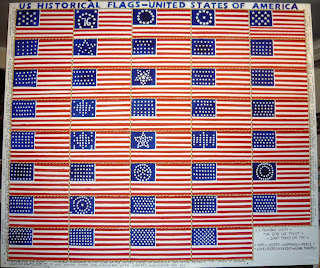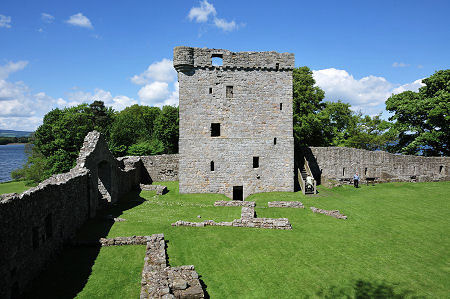ARE YOU WITH US OR AGAINST US?
That seems like a pretty direct question and one most people could answer if it was put to them. But how do I know if you are a distance away from me and I cannot speak to you directly? And how do I know if you are telling the truth? Are you friend or foe? What is it exactly, that you stand for or behind? That is the nature of the history of flags.
I study medieval history so I know more than the average person about standards and flags. But I wouldn't say I am an expert. I decided to write this because of all of the recent political turmoil over flags. If you don't like the American flag or the Gadsden flag or the Confederate flag, just what do you stand for? It seems that people don't know the history of flags in general or our American flags specifically and only know what they have been told.
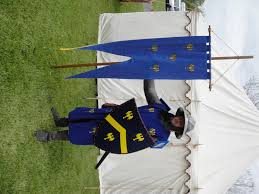

Standards were used by ancient Assyrians, Egyptians, and Hebrews. The Shahdad Standard is sometimes said to be the oldest flag in existence, but I will just say it is the oldest flag ever found in Iran. It isn't what we would think of as a flag since it is made of bronze. It is a metal square, mounted on a pole and is made so that it can sort of spin around the pole. On the top of the pole, is an eagle with spread wings. The images on it represent people praying to a rain goddess for water and show an ancient irrigation method that dates from the third and fourth millennium BCE in Shahdad.

"The colors of Thotmes I flew before the gates from tall fir flagpoles brought upstream from Lebanon." Hatshepsut, a Biography, Evelyn Wells, page 65, Doubleday & Co, Garden City, New York, 1969. This may be more like Roman vexilloids.
There are also accounts of flags flying in front of Egyptian temples, giving them a religious significance. And I have read that the Egyptian hieroglyph for god was a temple flag. That would be about 3000-4000 BCE.
Some of the ancient Indian writings have flags in them and those would have been about 5000 years ago. The Emblem on the flag of the Arjuna chariot was Hanuman, a character from Indian mythology. The flag was called "Kapi Dhwaj". https://en.wikipedia.org/wiki/Arjuna
What was a Roman vexillum? It was more or less a rectangular piece of cloth that hung straight down from a crossbar at the top of a pole. They hung up and down, whereas we fly flags horizontally. It is a diminutive form of the word velum with means sail, and therefore vexilla were “little sails”. They represented a military unit and were closely defended and guarded in combat. The only artifact we have of these is dated to around the 3rd century AD and is in the Pushkin Museum of Fine Arts. Again, it has a religious icon on it in the form of the goddess Victoria.
https://en.wikipedia.org/wiki/Vexillum
There are many references to standards, ensigns, and banners in the Bible.
"You have given a banner to those who fear You, that it may be displayed because of the truth." (Psalm 60:4)
In Biblical references, banners signify, celebration and possession and to show identity. They gave people a spiritual place to rally and literally a physical place to rally, a way to tell you where you were supposed to be at.
Numbers 2:3
"Now those who camp on the east side toward the sunrise shall be of the standard of the camp of Judah, by their armies, and the leader of the sons of Judah: Nahshon the son of Amminadab,
Numbers 2:34
“Thus the sons of Israel did; according to all that the LORD commanded Moses, so they camped by their standards, and so they set out, every one by his family according to his father's household.”
Psalm 20:5
“We will sing for joy over your victory, And in the name of our God we will set up our banners May the LORD fulfill all your petitions.”
Psalm 60:4
“You have given a banner to those who fear You, That it may be displayed because of the truth. Selah”
All of the above are examples of the tribes of Israel being told to divide themselves under individual banners so that people would know what tribe they were from; to put up banners in battle so their enemies would fear them, and to put them up as a sign of victory and celebration. https://www.crwflags.com/fotw/flags/il_tribe.html

As I have already pointed out, in the ancient world, flags often had religious meaning and significance. The red flag with a white cross known as the Dannebrog of Denmark is considered to be the oldest flag design still in use. It used to be spelled Danebrog. It has been used by Danish kings since the 1300s and before that, it's origin in legend dates to the Battle of Lyndanisse of 1219. The legend says that the Danes were in battle during the Crusades against the Estonians and they needed a rallying point and a flag miraculously fell from the sky. I'm not quite buying that, but it holds true to the religious significance of early flags and the importance of national identity and mythology.
If you are interested in coats of arms, Wikipedia has some interesting information on the Kings of Denmark using this Crusader flag on the arms. It is an unusual thing to do and may reflect either that it was given to them by the Pope or as a way of associating themselves with the Knights Hospitaller. Both are viable, given the more well-known flag that is its reverse, white with a red cross, or sometimes, black and white with a red cross.
https://en.wikipedia.org/wiki/Flag_of_Denmark
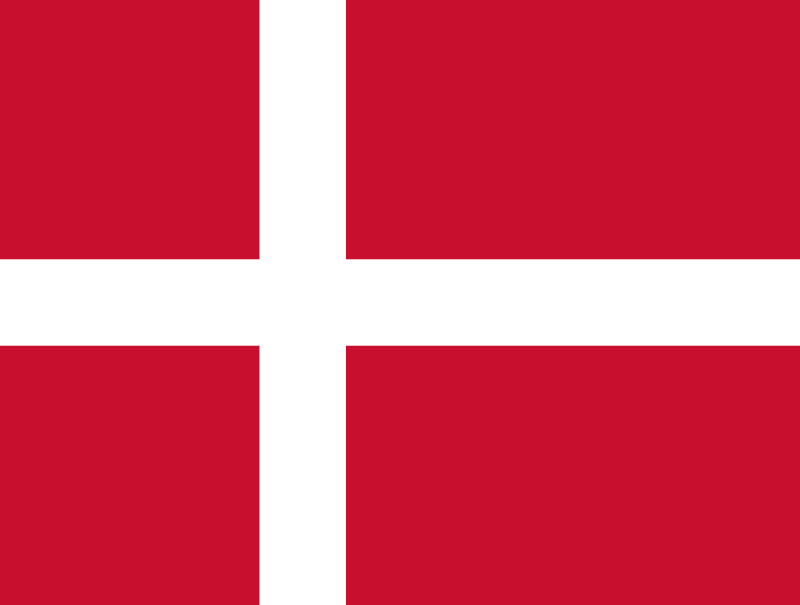
By medieval times, banners were usually battle flags. It was usually quadrangular in shape had had the arms of the person entitled to carry it on it. There are many other types of flags, such as a banderole which is similar to a banner. It is long and narrow with a cleft in it and was usually flown from the staff of a soldier or from the masthead of a ship. We've all seen photos of those on early ships, we just probably didn't know what they were called. They look more like streamers than flags. https://en.wikipedia.org/wiki/Banderole
During the Middle Ages, there were all sorts and they all had a purpose, but the one thing they had in common was to signify whose army you belonged to. And in effect tell you where you were supposed to be if you got separated from the rest of your men in the heat of battle. The gonfalon is one of the more iconic looking flags, it is hung from a crossbar at the top of a staff and usually had the arms of some noble on them. They were exactly the same as the ancient Roman vexillum in appearance. And similar to those is the standard. The difference between a gonfalon and a standard is that a standard bears the armorial markings all the way down the length of the flag onto the tailed area, and a gonfalon only has the markings on the upper larger area. For early medieval people these often had a religious significance and they were carried in front of religious processions and it was considered a holy act to be the bearer of a gonfalon, and you might gain favor with God, Jesus, Mary or the saints.
https://en.wikipedia.org/wiki/Gonfalon
In medieval France, they used the Chape de St. Martin, originally kept in Marmoutier abbey, was borne upon the standards of the early kings. St. Martin was the Bishop of Tours. He was born about 316 AD. It is believed that he was a member of the Equites catafractarii Ambianenses, a heavy cavalry unit listed in the Notitia Dignitatum. It was stationed at Milan and is also recorded at Treves, it was probably part of the elite cavalry bodyguard of the Emperor, which went with him when he traveled through the Empire. Although he was a soldier, he is also said to have been a Christian from the age of ten. In later life, he became a cleric. While he was still a soldier, he had a vision. In his vision, he came upon a beggar. He cut his cloak in half to share with the beggar, who later was revealed to be Jesus. The half of the cloak he kept was carried by the Merovingian kings into battle and oaths were sworn on it. The person who carried the cape was called a “cappellanu” and from there, all priests who also served in the military were called, “ cappellani”, and that evolved into “chapelains” and the English, “chaplain”.
The Cape of St. Martin was succeeded by the oriflamme, the ancient banner of the abbey of St. Denis. This is an interesting one. When it was carried in battle, no prisoners would be taken until it was lowered. The idea was to instill fear into the hearts of the enemy because generally, the nobles could count on being taken prisoner so that ransoms could be collected for their release. As long as the oriflamme was flying, they were assured to be killed. One of the first places it is mentioned is in the Chanson de Roland. It's great classical reading if you like Arthurian legend. According to legend, Charlemagne carried it to the Holy Land because of a prophecy about a knight carrying a golden lance, from which flames would burn and drive out the Saracens. This suggests that the lance was originally the important object, with the banner simply a decoration, but this changed over time. This was the Spear of Destiny. It was also used by the Capetian kings.

The Valois kings used a blue background with fleurs-de-lis on them from about 1328. And later during the Bourbon restoration, a white flag with fleurs-de-lis was used. The fleurs-de-lis itself is often a religious emblem. It is said to show the three social classes during the Middle Ages: those who worked, those who fought, and those who prayed. It also represents purity, from a miracle associated with Clovis I and with the anointing of kings, considered to have a divine right to rule. It is an iris and not a lily, however, named after the river Leie in Flanders from which come the Counts of Flanders. Again, the heraldry associated with it is interesting. I've read about it a good deal because it is associated with my Lilly ancestors, descended from the Counts of Flanders. It has been passed through dynastic intermarriage through most of the royal houses of Europe. https://en.wikipedia.org/wiki/Fleur-de-lis

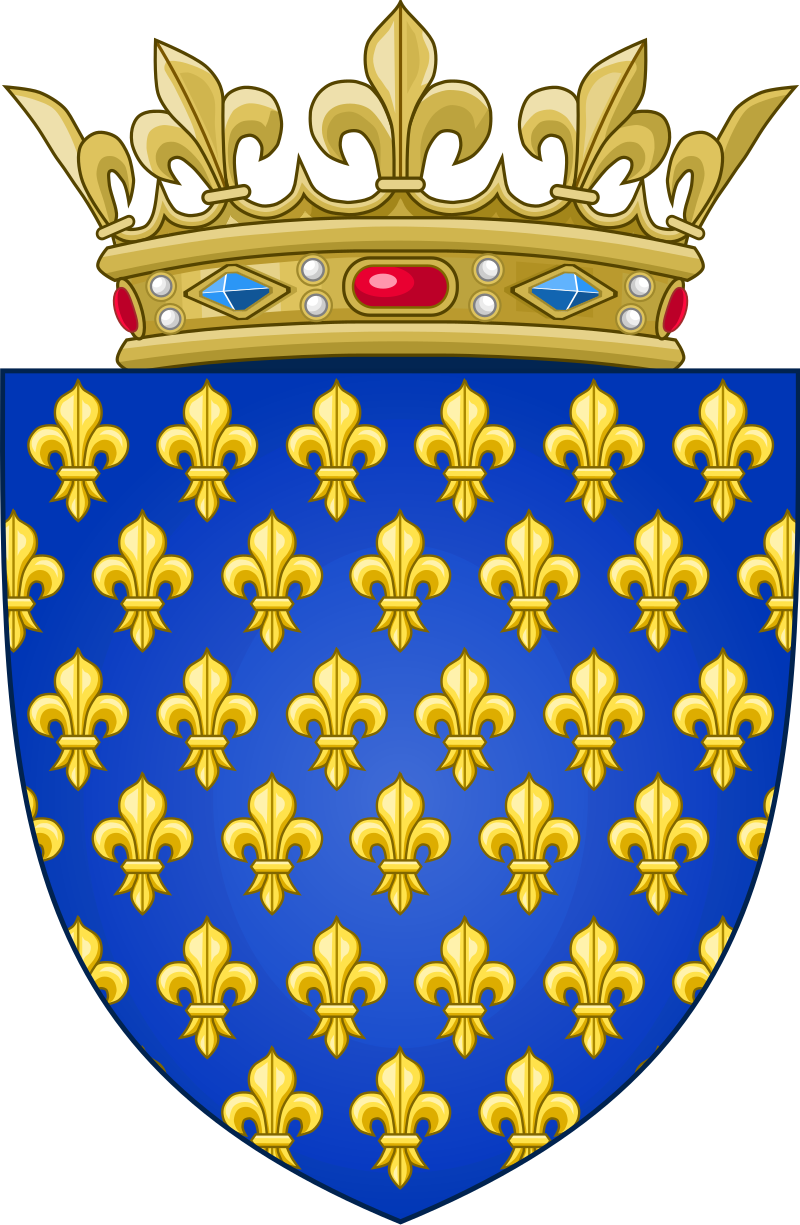
In turn, this was succeeded by the tricolor at the time of the Revolution. The red white and blue on the French flag represents a sort of culmination of all of the above. Blue is associated with St. Martin, red with St. Denis and the oriflamme, and are the colors of Paris. They are also the colors of the Virgin Mary. And white has anciently been a French color. They are said now to represent, blue-freedom, white- equality, red-brotherhood. https://en.wikipedia.org/wiki/Flag_of_France

William the Conqueror received his banner from the pope when he set out to invade England in 1066 and take what he believed to be his rightful throne.
![[William's flag]](https://www.crwflags.com/fotw/images/f/fr_bayt1.gif)
The ensign of Great Britain, the Union Jack (or Union Flag), is formed by the crosses of St. George, St. Andrew, and St. Patrick, the national saints, respectively, of England, Scotland, and Ireland.

The cross of St. George was used by King Henry II when he went on crusade in 1188. The Cross of St. Andrew originated in a 9th-century battle, where Óengus II led a combined force of Picts and Scots to victory over the Angles, led by Æthelstan. Supposedly, a miraculous white saltire (another word of French origin for St. Andrew's Cross) appeared in the blue sky and Óengus' troops were roused to victory by the omen. The Cross of St. Patrick forms the 'X' shape on the British flag. But it really isn't anything to do with St. Patrick, but instead, it represents the Order of St. Patrick, which honored people who supported the Anglo-Irish government in Ireland.
So up until the 1780s flags and banners were still frequently holding some sort of religious meaning, as far as it pertained to the national identity of whoever flew them. But mainly, they showed who you were, where you were from, and what you stood to fight for.
I've seen a lot of negative things said about the Gadsden flag. It originated with our Founding Father Benjamin Franklin. He made a reference to the rattlesnake in a commentary that he published in 1751 in his Pennsylvania Gazette. Because it had been the policy of Great Britain to send convicts to America, he said that they should thank them by sending rattlesnakes back to England.
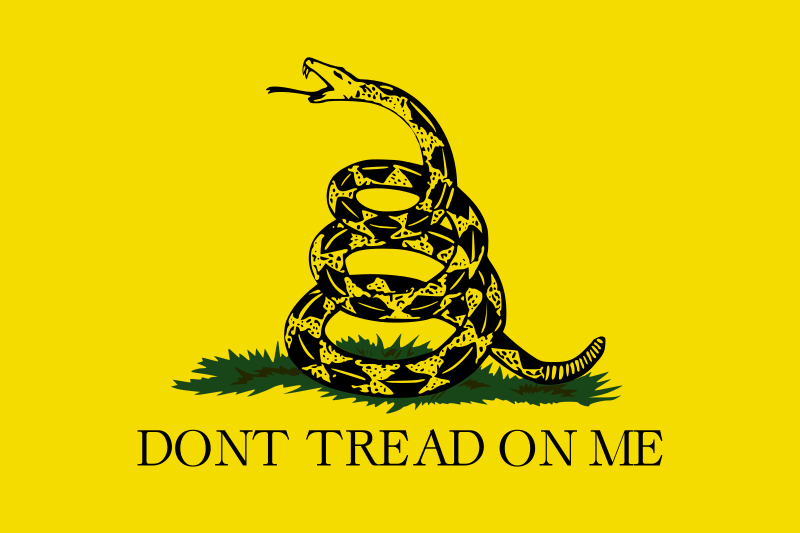
In 1754, while the French and Indian War was being fought, he published a woodcut of a snake cut into eight pieces to represent the colonies, with New England, joined as the head. Under it was the caption, “Join or Die”. He was basically saying that if the colonies didn't unite they would die. Paul Revere used the symbol in his paper the Massachusetts Spy, only he depicted it as fighting a British dragon.

Benjamin Franklin published an essay, in December 1775, in the Pennsylvania Journal using the pseudonym American Guesser. In it he says that the rattlesnake is a good symbol for the American spirit:
“I recollected that her eye excelled in brightness, that of any other animal, and that she has no eye-lids—She may therefore be esteemed an emblem of vigilance.—She never begins an attack, nor, when once engaged, ever surrenders: She is therefore an emblem of magnanimity and true courage.—As if anxious to prevent all pretensions of quarreling with her, the weapons with which nature has furnished her, she conceals in the roof of her mouth, so that, to those who are unacquainted with her, she appears to be a most defenseless animal; and even when those weapons are shown and extended for her defense, they appear weak and contemptible; but their wounds however small, are decisive and fatal:—Conscious of this, she never wounds till she has generously given notice, even to her enemy, and cautioned him against the danger of stepping on her.—Was I wrong, Sir, in thinking this a strong picture of the temper and conduct of America?”
In 1778, the Continental Congress adopted the symbol for the War Office, which was basically the army. In the center of the top of the Seal, there is a rattlesnake holding a banner which reads: "This We'll Defend". The US Army's Institute of Heraldry says that "'This We'll Defend,' on a scroll held by the rattlesnake is a symbol depicted on some American colonial flags and signifies the Army's constant readiness to defend and preserve the United States.' This design of the War Office Seal was carried forward - with some minor modifications - into the subsequent designs for the War Department's Seal, and the Department of the Army's Seal, Emblem and Flag. As such, the rattlesnake symbol has been in continuous official use by the US Army for over 236 years.
The Betsy Ross flag has recently come under attack and people on social media say it represents the era of slave ownership. If that is true and is the only thing it represents, then the only acceptable flag is any after the end of slavery. And it isn't acceptable to feel patriotic about anything before that time. To me that is absurd. Not every man who fought during the Revolutionary War or as the British called it, the American War, owned slaves. Many white people were sent here as indentured servants because of some crime they committed in England or because they had no other way to pay for their passage to what they hoped would be a better life. And they rallied around these flags.

If white supremacist groups are using these flags it is because they also believe in the original ideals that the Founding Fathers did. It is possible for a group of people to simultaneously have some admirable ideals and some deplorable ones. One of the things that have always defined America is the diversity of ideas.
Betsy Ross herself represents that diversity. If the only thing America stood for at the time was White Male Superiority then isn't it interesting that a woman designed this flag? She and her husband were not of the same faith and they eloped so that they could marry despite these differences. They were both indentured servants which does not mesh well with the idea of white male superiority either. It is uncertain if the story we were told in school about her designing a flag is true or not. But her relatives signed affidavits saying it was true after her death.
But at the time her flag was not the only one that Colonial soldiers flew. There were several. Most people just see her flag as a symbol of early America and the founding of our nation. At the time flags were just a military tool. We didn't have a standard flag representing our country even after the Flag Act of 1777 because it was open to interpretation.
“Resolved, that the flag of the United States be made of thirteen stripes, alternate red and white; that the union be thirteen stars, white in a blue field, representing a new Constellation.”
For the next 135 years or so how those stars and stripes were arranged was up to the maker of the flag.
Guidons are shaped like a rectangular flag with a triangle missing from one end. In the United States it was originally carried by cavalry. And is now used by almost all units of the military in dress parades to distinguish the different units. With respect to our military, it is considered a great honor to be the guidon bearer. The bearer stands next to the commander in front of their unit. It represents your unit and your commanding officer. It is the rallying point for the other men in the unit to fall into formation on order. And the commander and guidon bearer are always in front of the formation in drills and ceremonies. When your commanding officer is in, their guidon is on display. And when they leave it is taken down. If anyone does anything that is a disgrace to the guidon, then it is considered a disgrace to the entire unit and should be punished. If the bearer drops the guidon he has to fall with it and do push ups. Imagine the affront a soldier would take to someone from outside their unit disgracing their guidon. You can go here and see some beautiful examples of American guidons. https://en.wikipedia.org/wiki/Guidon_(United_States)
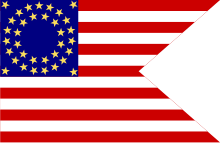
As I see it, there is no reason to see our flags only through the eyes of white supremacists or through the eyes of the NAACP. We can choose to associate them with the admirable ideals that the Founding Fathers and other early Americans had and stood for. The attack on American flags of all types seems to me to be an affront to American history and what it means to be an American. It seems as if certain political groups would like it to be impossible for us to know who is friend or foe and what we stand for and stand under. Revisionists are more divisive than any flag could ever be. If there isn't a stop put to it, we won't have anything to rally around or to unify us. That is the ultimate purpose of a flag, to unify us.
I prefer to see the flag through the eyes of valiant men like Ira Hayes. He was a Pima Indian who fought in WWII and was immortalized in a photo raisin an American flag in the famous photograph of the flag raising on Iwo Jima https://en.wikipedia.org/wiki/Raising_the_Flag_on_Iwo_Jima
Three of the men in the photograph were killed in the next few days.


That seems like a pretty direct question and one most people could answer if it was put to them. But how do I know if you are a distance away from me and I cannot speak to you directly? And how do I know if you are telling the truth? Are you friend or foe? What is it exactly, that you stand for or behind? That is the nature of the history of flags.
I study medieval history so I know more than the average person about standards and flags. But I wouldn't say I am an expert. I decided to write this because of all of the recent political turmoil over flags. If you don't like the American flag or the Gadsden flag or the Confederate flag, just what do you stand for? It seems that people don't know the history of flags in general or our American flags specifically and only know what they have been told.

Standards were used by ancient Assyrians, Egyptians, and Hebrews. The Shahdad Standard is sometimes said to be the oldest flag in existence, but I will just say it is the oldest flag ever found in Iran. It isn't what we would think of as a flag since it is made of bronze. It is a metal square, mounted on a pole and is made so that it can sort of spin around the pole. On the top of the pole, is an eagle with spread wings. The images on it represent people praying to a rain goddess for water and show an ancient irrigation method that dates from the third and fourth millennium BCE in Shahdad.

"The colors of Thotmes I flew before the gates from tall fir flagpoles brought upstream from Lebanon." Hatshepsut, a Biography, Evelyn Wells, page 65, Doubleday & Co, Garden City, New York, 1969. This may be more like Roman vexilloids.
There are also accounts of flags flying in front of Egyptian temples, giving them a religious significance. And I have read that the Egyptian hieroglyph for god was a temple flag. That would be about 3000-4000 BCE.
Some of the ancient Indian writings have flags in them and those would have been about 5000 years ago. The Emblem on the flag of the Arjuna chariot was Hanuman, a character from Indian mythology. The flag was called "Kapi Dhwaj". https://en.wikipedia.org/wiki/Arjuna
What was a Roman vexillum? It was more or less a rectangular piece of cloth that hung straight down from a crossbar at the top of a pole. They hung up and down, whereas we fly flags horizontally. It is a diminutive form of the word velum with means sail, and therefore vexilla were “little sails”. They represented a military unit and were closely defended and guarded in combat. The only artifact we have of these is dated to around the 3rd century AD and is in the Pushkin Museum of Fine Arts. Again, it has a religious icon on it in the form of the goddess Victoria.
https://en.wikipedia.org/wiki/Vexillum
There are many references to standards, ensigns, and banners in the Bible.
"You have given a banner to those who fear You, that it may be displayed because of the truth." (Psalm 60:4)
In Biblical references, banners signify, celebration and possession and to show identity. They gave people a spiritual place to rally and literally a physical place to rally, a way to tell you where you were supposed to be at.
Numbers 2:3
"Now those who camp on the east side toward the sunrise shall be of the standard of the camp of Judah, by their armies, and the leader of the sons of Judah: Nahshon the son of Amminadab,
Numbers 2:34
“Thus the sons of Israel did; according to all that the LORD commanded Moses, so they camped by their standards, and so they set out, every one by his family according to his father's household.”
Psalm 20:5
“We will sing for joy over your victory, And in the name of our God we will set up our banners May the LORD fulfill all your petitions.”
Psalm 60:4
“You have given a banner to those who fear You, That it may be displayed because of the truth. Selah”
All of the above are examples of the tribes of Israel being told to divide themselves under individual banners so that people would know what tribe they were from; to put up banners in battle so their enemies would fear them, and to put them up as a sign of victory and celebration. https://www.crwflags.com/fotw/flags/il_tribe.html
As I have already pointed out, in the ancient world, flags often had religious meaning and significance. The red flag with a white cross known as the Dannebrog of Denmark is considered to be the oldest flag design still in use. It used to be spelled Danebrog. It has been used by Danish kings since the 1300s and before that, it's origin in legend dates to the Battle of Lyndanisse of 1219. The legend says that the Danes were in battle during the Crusades against the Estonians and they needed a rallying point and a flag miraculously fell from the sky. I'm not quite buying that, but it holds true to the religious significance of early flags and the importance of national identity and mythology.
If you are interested in coats of arms, Wikipedia has some interesting information on the Kings of Denmark using this Crusader flag on the arms. It is an unusual thing to do and may reflect either that it was given to them by the Pope or as a way of associating themselves with the Knights Hospitaller. Both are viable, given the more well-known flag that is its reverse, white with a red cross, or sometimes, black and white with a red cross.
https://en.wikipedia.org/wiki/Flag_of_Denmark

By medieval times, banners were usually battle flags. It was usually quadrangular in shape had had the arms of the person entitled to carry it on it. There are many other types of flags, such as a banderole which is similar to a banner. It is long and narrow with a cleft in it and was usually flown from the staff of a soldier or from the masthead of a ship. We've all seen photos of those on early ships, we just probably didn't know what they were called. They look more like streamers than flags. https://en.wikipedia.org/wiki/Banderole
During the Middle Ages, there were all sorts and they all had a purpose, but the one thing they had in common was to signify whose army you belonged to. And in effect tell you where you were supposed to be if you got separated from the rest of your men in the heat of battle. The gonfalon is one of the more iconic looking flags, it is hung from a crossbar at the top of a staff and usually had the arms of some noble on them. They were exactly the same as the ancient Roman vexillum in appearance. And similar to those is the standard. The difference between a gonfalon and a standard is that a standard bears the armorial markings all the way down the length of the flag onto the tailed area, and a gonfalon only has the markings on the upper larger area. For early medieval people these often had a religious significance and they were carried in front of religious processions and it was considered a holy act to be the bearer of a gonfalon, and you might gain favor with God, Jesus, Mary or the saints.
https://en.wikipedia.org/wiki/Gonfalon
In medieval France, they used the Chape de St. Martin, originally kept in Marmoutier abbey, was borne upon the standards of the early kings. St. Martin was the Bishop of Tours. He was born about 316 AD. It is believed that he was a member of the Equites catafractarii Ambianenses, a heavy cavalry unit listed in the Notitia Dignitatum. It was stationed at Milan and is also recorded at Treves, it was probably part of the elite cavalry bodyguard of the Emperor, which went with him when he traveled through the Empire. Although he was a soldier, he is also said to have been a Christian from the age of ten. In later life, he became a cleric. While he was still a soldier, he had a vision. In his vision, he came upon a beggar. He cut his cloak in half to share with the beggar, who later was revealed to be Jesus. The half of the cloak he kept was carried by the Merovingian kings into battle and oaths were sworn on it. The person who carried the cape was called a “cappellanu” and from there, all priests who also served in the military were called, “ cappellani”, and that evolved into “chapelains” and the English, “chaplain”.
The Cape of St. Martin was succeeded by the oriflamme, the ancient banner of the abbey of St. Denis. This is an interesting one. When it was carried in battle, no prisoners would be taken until it was lowered. The idea was to instill fear into the hearts of the enemy because generally, the nobles could count on being taken prisoner so that ransoms could be collected for their release. As long as the oriflamme was flying, they were assured to be killed. One of the first places it is mentioned is in the Chanson de Roland. It's great classical reading if you like Arthurian legend. According to legend, Charlemagne carried it to the Holy Land because of a prophecy about a knight carrying a golden lance, from which flames would burn and drive out the Saracens. This suggests that the lance was originally the important object, with the banner simply a decoration, but this changed over time. This was the Spear of Destiny. It was also used by the Capetian kings.

The Valois kings used a blue background with fleurs-de-lis on them from about 1328. And later during the Bourbon restoration, a white flag with fleurs-de-lis was used. The fleurs-de-lis itself is often a religious emblem. It is said to show the three social classes during the Middle Ages: those who worked, those who fought, and those who prayed. It also represents purity, from a miracle associated with Clovis I and with the anointing of kings, considered to have a divine right to rule. It is an iris and not a lily, however, named after the river Leie in Flanders from which come the Counts of Flanders. Again, the heraldry associated with it is interesting. I've read about it a good deal because it is associated with my Lilly ancestors, descended from the Counts of Flanders. It has been passed through dynastic intermarriage through most of the royal houses of Europe. https://en.wikipedia.org/wiki/Fleur-de-lis


In turn, this was succeeded by the tricolor at the time of the Revolution. The red white and blue on the French flag represents a sort of culmination of all of the above. Blue is associated with St. Martin, red with St. Denis and the oriflamme, and are the colors of Paris. They are also the colors of the Virgin Mary. And white has anciently been a French color. They are said now to represent, blue-freedom, white- equality, red-brotherhood. https://en.wikipedia.org/wiki/Flag_of_France

William the Conqueror received his banner from the pope when he set out to invade England in 1066 and take what he believed to be his rightful throne.
![[William's flag]](https://www.crwflags.com/fotw/images/f/fr_bayt1.gif)
The ensign of Great Britain, the Union Jack (or Union Flag), is formed by the crosses of St. George, St. Andrew, and St. Patrick, the national saints, respectively, of England, Scotland, and Ireland.

The cross of St. George was used by King Henry II when he went on crusade in 1188. The Cross of St. Andrew originated in a 9th-century battle, where Óengus II led a combined force of Picts and Scots to victory over the Angles, led by Æthelstan. Supposedly, a miraculous white saltire (another word of French origin for St. Andrew's Cross) appeared in the blue sky and Óengus' troops were roused to victory by the omen. The Cross of St. Patrick forms the 'X' shape on the British flag. But it really isn't anything to do with St. Patrick, but instead, it represents the Order of St. Patrick, which honored people who supported the Anglo-Irish government in Ireland.
So up until the 1780s flags and banners were still frequently holding some sort of religious meaning, as far as it pertained to the national identity of whoever flew them. But mainly, they showed who you were, where you were from, and what you stood to fight for.
I've seen a lot of negative things said about the Gadsden flag. It originated with our Founding Father Benjamin Franklin. He made a reference to the rattlesnake in a commentary that he published in 1751 in his Pennsylvania Gazette. Because it had been the policy of Great Britain to send convicts to America, he said that they should thank them by sending rattlesnakes back to England.

In 1754, while the French and Indian War was being fought, he published a woodcut of a snake cut into eight pieces to represent the colonies, with New England, joined as the head. Under it was the caption, “Join or Die”. He was basically saying that if the colonies didn't unite they would die. Paul Revere used the symbol in his paper the Massachusetts Spy, only he depicted it as fighting a British dragon.

Benjamin Franklin published an essay, in December 1775, in the Pennsylvania Journal using the pseudonym American Guesser. In it he says that the rattlesnake is a good symbol for the American spirit:
“I recollected that her eye excelled in brightness, that of any other animal, and that she has no eye-lids—She may therefore be esteemed an emblem of vigilance.—She never begins an attack, nor, when once engaged, ever surrenders: She is therefore an emblem of magnanimity and true courage.—As if anxious to prevent all pretensions of quarreling with her, the weapons with which nature has furnished her, she conceals in the roof of her mouth, so that, to those who are unacquainted with her, she appears to be a most defenseless animal; and even when those weapons are shown and extended for her defense, they appear weak and contemptible; but their wounds however small, are decisive and fatal:—Conscious of this, she never wounds till she has generously given notice, even to her enemy, and cautioned him against the danger of stepping on her.—Was I wrong, Sir, in thinking this a strong picture of the temper and conduct of America?”
In 1778, the Continental Congress adopted the symbol for the War Office, which was basically the army. In the center of the top of the Seal, there is a rattlesnake holding a banner which reads: "This We'll Defend". The US Army's Institute of Heraldry says that "'This We'll Defend,' on a scroll held by the rattlesnake is a symbol depicted on some American colonial flags and signifies the Army's constant readiness to defend and preserve the United States.' This design of the War Office Seal was carried forward - with some minor modifications - into the subsequent designs for the War Department's Seal, and the Department of the Army's Seal, Emblem and Flag. As such, the rattlesnake symbol has been in continuous official use by the US Army for over 236 years.
The Betsy Ross flag has recently come under attack and people on social media say it represents the era of slave ownership. If that is true and is the only thing it represents, then the only acceptable flag is any after the end of slavery. And it isn't acceptable to feel patriotic about anything before that time. To me that is absurd. Not every man who fought during the Revolutionary War or as the British called it, the American War, owned slaves. Many white people were sent here as indentured servants because of some crime they committed in England or because they had no other way to pay for their passage to what they hoped would be a better life. And they rallied around these flags.

If white supremacist groups are using these flags it is because they also believe in the original ideals that the Founding Fathers did. It is possible for a group of people to simultaneously have some admirable ideals and some deplorable ones. One of the things that have always defined America is the diversity of ideas.
Betsy Ross herself represents that diversity. If the only thing America stood for at the time was White Male Superiority then isn't it interesting that a woman designed this flag? She and her husband were not of the same faith and they eloped so that they could marry despite these differences. They were both indentured servants which does not mesh well with the idea of white male superiority either. It is uncertain if the story we were told in school about her designing a flag is true or not. But her relatives signed affidavits saying it was true after her death.
But at the time her flag was not the only one that Colonial soldiers flew. There were several. Most people just see her flag as a symbol of early America and the founding of our nation. At the time flags were just a military tool. We didn't have a standard flag representing our country even after the Flag Act of 1777 because it was open to interpretation.
“Resolved, that the flag of the United States be made of thirteen stripes, alternate red and white; that the union be thirteen stars, white in a blue field, representing a new Constellation.”
For the next 135 years or so how those stars and stripes were arranged was up to the maker of the flag.
Guidons are shaped like a rectangular flag with a triangle missing from one end. In the United States it was originally carried by cavalry. And is now used by almost all units of the military in dress parades to distinguish the different units. With respect to our military, it is considered a great honor to be the guidon bearer. The bearer stands next to the commander in front of their unit. It represents your unit and your commanding officer. It is the rallying point for the other men in the unit to fall into formation on order. And the commander and guidon bearer are always in front of the formation in drills and ceremonies. When your commanding officer is in, their guidon is on display. And when they leave it is taken down. If anyone does anything that is a disgrace to the guidon, then it is considered a disgrace to the entire unit and should be punished. If the bearer drops the guidon he has to fall with it and do push ups. Imagine the affront a soldier would take to someone from outside their unit disgracing their guidon. You can go here and see some beautiful examples of American guidons. https://en.wikipedia.org/wiki/Guidon_(United_States)

As I see it, there is no reason to see our flags only through the eyes of white supremacists or through the eyes of the NAACP. We can choose to associate them with the admirable ideals that the Founding Fathers and other early Americans had and stood for. The attack on American flags of all types seems to me to be an affront to American history and what it means to be an American. It seems as if certain political groups would like it to be impossible for us to know who is friend or foe and what we stand for and stand under. Revisionists are more divisive than any flag could ever be. If there isn't a stop put to it, we won't have anything to rally around or to unify us. That is the ultimate purpose of a flag, to unify us.
I prefer to see the flag through the eyes of valiant men like Ira Hayes. He was a Pima Indian who fought in WWII and was immortalized in a photo raisin an American flag in the famous photograph of the flag raising on Iwo Jima https://en.wikipedia.org/wiki/Raising_the_Flag_on_Iwo_Jima
Three of the men in the photograph were killed in the next few days.



